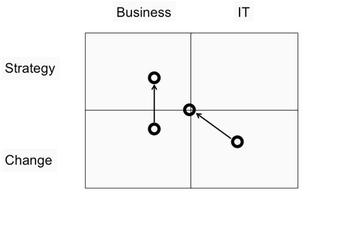Career navigation for process professionals: A simple framework
Add bookmark
|
A plethora of new job roles have come out in recent years to contend with the technical challenges that confront businesses. Process professionals occupy a place in and overlap with these roles. But has it all become a little too confusing? How can you navigate these career waters safely? Contributors Sharm Manwani and Barry Shore, business school professors in the UK and US, propose a simple framework. For decades, aligning Business and IT has ranked among the top three concerns of CIOs. Yet this gap prevails. At issue, is the way to deliver IT that aligns with the business strategy. Similarly, many organizations fail to deliver the change programs that will implement the strategy. Thomas Edison put it best when he said that "vision without execution is hallucination." These two gaps of alignment and execution become ever more critical in today’s fast-moving world. With increasing frequency IT is at the center of innovative business design and a number of hybrid roles have emerged to deal with these gaps. These roles often overlap yet there is little guidance on how professionals should navigate from one role to another. |
Swimming in difficult career waters |
Decades ago, the analyst specified the requirements with the user, the programmer coded the specification, and the operator ran the programs on a computer. OK, it was a little more complex than that but role definitions had a core simplicity.
Over time these roles evolved to address the increasing complexity associated with changing strategies, shorter product life cycles and integrated IT solutions. Yet the responsibilities and boundaries of these new roles often lead to confusion about the analyst’s role. One longer-term example is the business analyst role since the range spans both non-IT roles and the IT systems analyst.
In addition, we have seen new analysis type roles emerge such as business process specialist, enterprise architect, change manager, relationship manager, and business architect. We deliberately exclude program and service management roles from this analysis although these can add to the challenge of clear role definitions.
To help address this issue, we propose a framework to position the current and future focus of business IT professionals. Our goal is that this will help different analysis professionals (and their associations) to understand the range of available roles and navigate their career paths.
The proposed 2x2 framework has the pros and cons of a simple framework. It has been used with over 100 business IT professionals to position where they are today and their future career directions. The two dimensions reflect the gaps introduced at the start of the article: namely Business and IT on one axis and Strategy and Change (Execution) on the other axis.
Data were collected from Henley Business School program participants and BCS specialist group members, all of whom are experienced business IT professionals. Using the framework, these audiences were asked to consult with a peer and then indicate their current and desired career focus.
Responses showed a starting position and a direction with examples shown in the framework below.
Business IT Professional Focus Framework (Manwani, 2011)
Three main trends were observed. Firstly, there was a tendency for IT professionals to target a more business-oriented role. There was recognition that in doing so they might lose some of their deeper technical skills but this was generally considered an acceptable trade-off.
Secondly, there was a trend for those operating in the change roles to want to move to a more strategy focused role. This was seen to be more influential in the organization although one person expressed an interest in moving in the other direction to get involved in delivery at the sharp end.
Thirdly, a significant number of participants wanted to move into hybrid roles between business and IT (in Strategy, Change or both these areas).
It was interesting to observe that all the participants were comfortable with using the framework to position their career path after a short discussion with their peers. We have also found that we can use the framework to map existing business and IT analysis roles.
The following perspectives are not intended to be definitive since we have observed that scope can be organizationally dependent. We see Systems Analysts operating mainly in the IT and Change quadrant since their focus is typically on delivering the system, even though we recognize they need to be business-oriented to understand and challenge the requirements.
Similarly, we position Business Analysts in the Business and Change quadrant, since they primarily need to capture the requirements and consider how these will be implemented. An important variant of this role is the Business Process specialist which has emerged in response to the increased focus on understanding and defining business processes prior to developing IT solutions.
In the IT and Strategy quadrant, organizations may have IT Strategy and Governance roles as well as IT Architects. In contrast, Solution Architects typically work in the IT Change space. A role that is growing in prominence is the Business Architect which operates mainly in the Business and Strategy quadrant. Often the role reports into the CIO organization but there are also examples of it being located in the COO organization.
While many of these roles are rightly perceived as hybrid business and IT, most have a centre of gravity in one quadrant. One that is certainly targeted as a fully hybrid role is that of Relationship Manager which attempts to bridge the gap between Business and IT through individuals who understand both business needs and IT assets. We consider its existence to be an unfortunate indicator of the (mis)alignment in many organizations! Our view is that relationship management is a skill and focus that should be a requirement of all the above roles.
We are strong believers that business schools should develop programs that take a holistic view of the four quadrants, all the way from strategic alignment to benefits realization in the IT-Enabled Business Change lifecycle. We would also like to see professional associations who support these diverse Business IT professional roles collaborating with each other and with business schools to define career paths and capability development.
Given the target audience, we suggest that process professionals position their own and other roles in their organization across all four quadrants of the framework. They should then evaluate how they collaborate with the other roles to ensure an end-to-end view of the IT Enabled Business Change Lifecycle. In doing so, we believe they will not only enhance the performance of their current role but will be able to assess their potential to take on other roles.
Where do you see yourself as a process professional? Are you driving business change or strategy? Business or IT? Look out for future articles on skills development across the quadrants and change lifecycle.
[eventPDF]
References
Hybrid Skills - http://www.gartner.com/document/1855718?ref=seo
IT Enabled Business Change - http://www.bcs.org/category/10074





























